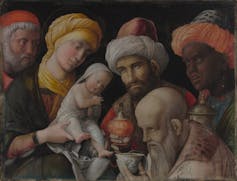In whose image?
This phenomenon was not restricted to Europe: There are 16th- and 17th-century pictures of Jesus with, for example, Ethiopian and Indian features. In Europe, however, the image of a light-skinned European Christ began to influence other parts of the world through European trade and colonization.

Artist Andrea Mantegna. The J. Paul Getty Museum
The Italian painter Andrea Mantegna’s “Adoration of the Magi” from A.D. 1505 features three distinct magi, who, according to one contemporary tradition, came from Africa, the Middle East, and Asia. They present expensive objects of porcelain, agate, and brass that would have been prized imports from China and the Persian and Ottoman empires. But Jesus’ light skin and blues eyes suggest that he is not Middle Eastern but European-born. And the faux-Hebrew script embroidered on Mary’s cuffs and hemline belie a complicated relationship to the Judaism of the Holy Family. In Mantegna’s Italy, anti-Semitic myths were already prevalent among the majority Christian population, with Jewish people often segregated to their own quarters of major cities.
Artists tried to distance Jesus and his parents from their Jewishness. Even seemingly small attributes like pierced ears – earrings were associated with Jewish women, their removal with a conversion to Christianity – could represent a transition toward the Christianity represented by Jesus. Much later, anti-Semitic forces in Europe including the Nazis would attempt to divorce Jesus totally from his Judaism in favor of an Aryan stereotype.
White Jesus abroad
As Europeans colonized increasingly farther-flung lands, they brought a European Jesus with them. Jesuit missionaries established painting schools that taught new converts Christian art in a European mode. A small altarpiece made in the school of Giovanni Niccolò, the Italian Jesuit who founded the “Seminary of Painters” in Kumamoto, Japan, around 1590, combines a traditional Japanese gilt and mother-of-pearl shrine with a painting of a distinctly white, European Madonna and Child.

Museo Nacional de Arte
In colonial Latin America – called “New Spain” by European colonists – images of a white Jesus reinforced a caste system where white, Christian Europeans occupied the top tier, while those with darker skin from perceived intermixing with native populations ranked considerably lower. Artist Nicolas Correa’s 1695 painting of Saint Rose of Lima, the first Catholic saint born in “New Spain,” shows her metaphorical marriage to a blond, light-skinned Christ.
Legacies of likeness
Scholar Edward J. Blum and Paul Harvey argue that in the centuries after European colonization of the Americas, the image of a white Christ associated him with the logic of empire and could be used to justify the oppression of Native and African Americans.
In a multiracial but unequal America, there was a disproportionate representation of a white Jesus in the media. It wasn’t only Warner Sallman’s Head of Christ that was depicted widely; a large proportion of actors who have played Jesus on television and film have been white with blue eyes.
Pictures of Jesus historically have served many purposes, from symbolically presenting his power to depicting his actual likeness. But representation matters, and viewers need to understand the complicated history of the images of Christ they consume.![]()
Anna Swartwood House, Assistant Professor of Art History, University of South Carolina
This article is republished from The Conversation under a Creative Commons license. Read the original article.



Each people depicts the characters of the history of Salvation with local features, to represent the universality of the Redemption.
The Christian churches and sanctuaries of Africa or Asia, or simply crossing the border with Mexico, it can be discovered that around the world there are Jesus with African physiognomy and Virgin Mary with mestizo or Chinese features. In the Yoruba cribs of the Nigerian south-west or in those of Tanzania, all the characters are African, they have not seen and the Chinese Madonna of Sheshan or the Mexican, therefore mestizo, Virgin of Guadalupe exists.
According to biblical revelation, God created the human being – man and woman – in his image and likeness (cf. Gen. 1, 26-27; 5, 1-2; 9, 6). This is the fundamental basis of human dignity and its inalienable rights which come not from the government, not from us, not from international agreements, but from God himself. Inalienable, fundamental human rights come from God the Creator.
The Church has the sublime vocation of realizing, in itself first of all, the unity of mankind beyond ethnic, cultural, national, social and other differences, in order to show precisely the transience of these differences, abolished by the Cross of Christ “(Pont. Comm. Justitia et Pax: The Church in the face of racism, n. 22). Indeed, the Church defines herself as “a sacrament or sign and instrument of the intimate union with God and of the unity of all mankind” (Vatican II: Lumen Gentium, n. 1)
Very informative article. A loving and infinite God made us in his image according to the book of Genesis. “Finite” man creates the images of Jesus (true man and true God) according to man’s particular cultural heritage and beliefs. These factors are influenced by oral history as well as by written tradition. “HIS”-story indeed!